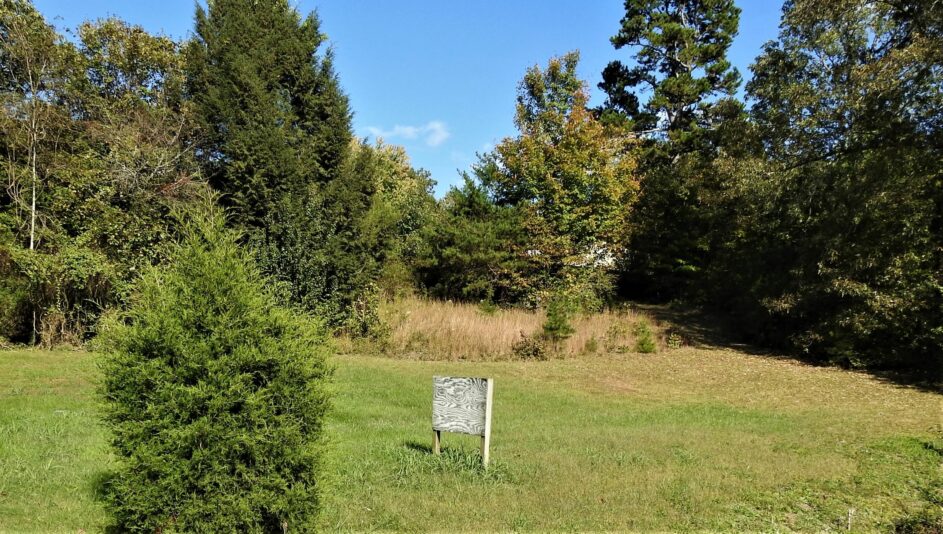There are more than 500 cemeteries and graveyards located across Knox County in varying stages of use (some are closed for good) and care (or neglect). Many are connected to churches that no longer exist or are family plots named for property owners whose stewardship of the attendant land passed decades ago. Many fall into a void of “who exactly is in charge of this?”
Such is the case for the old Van Loon Cemetery on Middlebrook Pike. The KGIS index to Knox County cemeteries actually lists the site as the Taggart Cemetery (aka Van Loon). It sits about halfway between Hoyle Beales Drive and Grassy Meadow Boulevard on the north side of Middlebrook, straddling the divide of Cedar Bluff and Karns in an area that used to be known simply as Ball Camp.
At present, the cemetery is mostly grown over with tall grasses, but has been used as recently as 2013. From the road, it looks like a small, tree-lined field with no discernable marker of its existence, save one faded wooden sign, whose words have long since vanished.

Elizabeth Van Loon
Whether or not there used to be a church of some sort located here is still under investigation. But the land for the cemetery was donated by one Benjamin Franklin Van Loon, born in Iowa in 1841 and who made his way to Knoxville by way of Memphis. In Memphis he met and married his wife, Elizabeth, whose first name may have been Sarah and whose birth name may have been Pearl, Phillips, Bailey or Hampton. Suffice it to say, that even by the late 19th century, proper record keeping was still squishy, especially where women were concerned.
Exactly why the Van Loons moved to Knox County, where they lived and how Benjamin made his money is unknown (for the moment). Despite the question as to her many name possibilities, there is actually more information about Elizabeth, which isn’t common among women of the Victorian age.
Elizabeth was born in Yancey County, North Carolina, March 6, 1844. By 1870, she was living in Memphis married to Benjamin and on December 18, 1874, gave birth to the couple’s one child, Frankie Elizabeth. Between the birth of Frankie and the family’s move to East Tennessee, Elizabeth had four novels published by T. B. Peterson and Brothers of Philadelphia: “The Shadow of Hampton Mead” (1878), “A Heart Twice Won” (1878), “Under the Willows” (1879), and “The Mystery of Allanwold” (1880).
Of the four, “The Shadow of Hampton Mead” appears to have been the most popular. It was still available by special order (barring finding an original copy) as recently as 2018 through Creative Media Partners LLC which stated, “This work has been selected by scholars as being culturally important, and is part of the knowledge base of civilization as we know it.” The description of the novel reads like classic Southern Gothic, and is indicative of Elizabeth’s love for the land of her roots in North Carolina. A full PDF of the novel is also available online.
 Perhaps profits from Elizabeth’s writing were enough to bring the family to Knox County, where they were established by 1885. Though Elizabeth was raised Episcopalian, she and Benjamin became part of the Restoration Movement (the precursor to the modern-day Church of Christ) here in Knox County. Benjamin deeded the land for the church (but was it built and what was it called?) and cemetery on Middlebrook. Beyond that, not much of his life is known.
Perhaps profits from Elizabeth’s writing were enough to bring the family to Knox County, where they were established by 1885. Though Elizabeth was raised Episcopalian, she and Benjamin became part of the Restoration Movement (the precursor to the modern-day Church of Christ) here in Knox County. Benjamin deeded the land for the church (but was it built and what was it called?) and cemetery on Middlebrook. Beyond that, not much of his life is known.
Elizabeth died on February 7, 1893, and was buried in the Van Loon Cemetery, though her grave is now unmarked. It is presumed (but not known) that if Benjamin remained in Knox County, he most likely is buried there as well. Their daughter, Frankie, married Henry Goosie, and has many descendants in the area.
Beth Kinnane is the community news editor for KnoxTNToday.com

